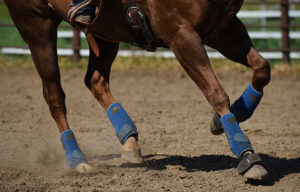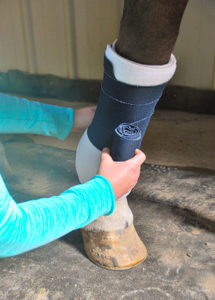Joint Injury: What to Do Before the Vet Arrives

Q: My horse came in from the field with what appears to be a puncture near his fetlock joint. His ankle is puffy and I can’t tell how deep the wound is, or if it goes into the joint. He does sometimes swell up over small scrapes. My veterinarian is coming to look at him tonight, but what should I do until then? Should I give him any medications, cold hose it, wrap it, or something else?
A: First, it’s great that you have already contacted your veterinarian. Wounds near joints should always be treated as emergencies. Joints comprise smooth cartilage that covers the bony surfaces, a thick capsule that surrounds the joint, and viscous synovial fluid that lubricates the joint as it moves. If the joint capsule is penetrated, bacteria are introduced into the joint. When a joint becomes infected, it is imperative to initiate treatment quickly. Otherwise, the cartilage surfaces sustain long-term damage and severe arthritis will develop.
When your veterinarian arrives, he or she will perform an exam to determine the depth and direction of the puncture wound. Your veterinarian’s strong working knowledge of anatomy helps him or her determine the risk of joint involvement. Based on the exam, he or she will decide if further diagnostics, such as sampling the synovial fluid, are warranted.
While it is critical to rule out joint involvement, in many cases swelling seen around a wound is due to cellulitis—an infection of the deep layers of the skin. Cellulitis still requires prompt medical attention but has a much better prognosis than an infected joint. Additionally, we all know horses can choose some rather creative ways of injuring themselves, so some of the swelling might be due to trauma associated with the injury.
There are a few things you can do while you are waiting to see your vet. You can gently clean the area around the wound with soap and water. Betadine scrub is great to have on hand for these situations. Then you can apply an antiseptic ointment such as silver sulfadiazine cream, cover the wound with a nonstick pad, and apply a standing bandage. The horse should be left in a stall until the vet can examine him. Your proactive care will help your horse have the best possible outcome.

Written by:
Emily Guest, DVM
Related Articles
Stay on top of the most recent Horse Health news with















